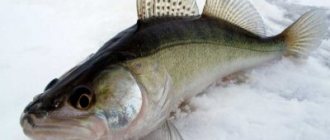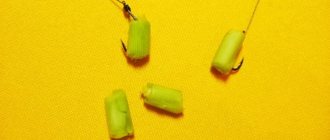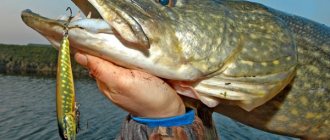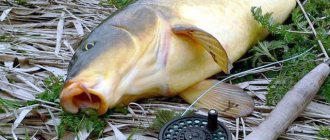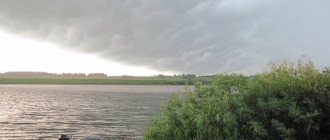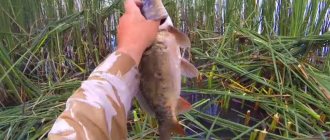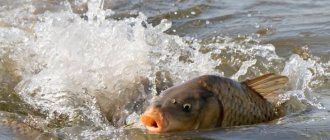The rules of amateur and sport fishing in the Russian Federation establish a number of restrictions on types and methods of fishing, fishing locations, restrictions on types and minimum sizes of fish, as well as periods during which fishing is prohibited.
Among the restrictions and prohibitions, there are those tied to certain areas and regions, and there are general ones that apply throughout the entire territory of the Russian Federation. These include:
- Prohibited fishing gear;
- Prohibited fishing methods;
- Places where fishing is prohibited.
Separately, it is worth remembering that there are additional restrictions on fishing during the spawning period (spawning ban). Prohibited periods and fishing places for 2021.
Fishing gear
Prohibited fishing gear includes:
- Any networks;
- Traps of any design and type, with the exception of crayfish traps, which are used for catching crayfish;
- Passive fishing gear (zakidushki, postavushka and others) on rivers in which trout live;
- Any types of gear (spinning rod, feeder and other bottom gear, float rod) with a total number of hooks exceeding 10 pieces per fisherman;
- Trawling and dredging fishing gear;
- Straining fishing gear (drags, seines, dragnets, bastings, lifts, televisions, screens, spiders, grips, drills, shards, capes, scarves, sacks and others), with the exception of lifts (spiders) and scoops, no larger than 1 by 1 meter and mesh no more than 10 mm, in an amount of no more than 1 per person;
- Any traps;
- Self-catching hook tackle;
- Piercing fishing gear, with the exception of special pistols and spearguns for underwater hunting;
- Firearms and air weapons, bows and crossbows;
- Fishing gear exposed to electric current, explosion, toxic chemicals.
For one fishing rod

Fishermen-poachers face a fine of half a million or a prison sentence
This year, the rules for fishing during spawning have been tightened.
While most of the restrictions apply at the regional level, the spawning ban is relevant for the whole of Russia. It is usually introduced in early April and lasts about two months. However, the exact dates will vary depending on the region each year. In some cases, the ban may also be introduced in stages, depending on when and what local fish species go to spawn.
In the Moscow region, for example, the spawning ban in 2021 is valid from April 1 to June 10, and in St. Petersburg the main ban is introduced from the beginning of ice melting and will be in effect until June 15. However, it will be impossible to catch pike perch and bream from May 20 to June 30.
The reason for introducing the ban is simple - catching one unspawned adult fish can lead to a “shortage” of dozens of adult fish after just a few years. So, because of one medium-sized pike caught, in three years the reservoir will be missing about 30 predators, the Federal Fisheries Agency explains.
Restrictions, by the way, apply not only to fishermen, but also to motor vessels - so that they cannot prevent the fish from spawning or destroy the eggs. But relaxation is still being made for amateur fishermen.
Fish_2
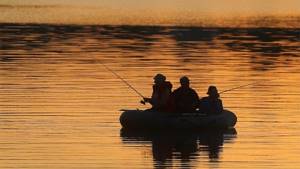
Violators will be fined for fishing from a boat or in spawning areas.
Photo: TASS/Vladimir Smirnov
During the spawning ban, you can:
fish from the shore outside of spawning areas, provided that only one fishing rod or donka, equipped with no more than two hooks, is used for this.
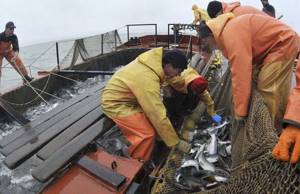
Fishing rules in Russia are planned to change
But for fishing from a boat or in spawning areas (they need to be clarified separately when going fishing), violators will already face a fine.
Fishing methods
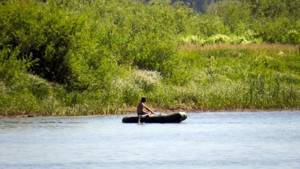
Prohibited methods include fishing:
- The method of purging, killing fish;
- By slings;
- For illumination in the dark, with the exception of fishing using fishing rods (including bottom ones) and spinning gear, as well as crayfish traps;
- On the track and trolling using more than two baits per vessel;
- For girders and mugs with a total number of hooks of more than 10 pcs per 1 angler;
- Using devices that completely or partially block the channel (dikes, fences, pins, dams and other types of barriers);
- By the gill method using “fat traps”, “harvesters” with more than two hooks;
- More than 5 shells per person, each side of which should not exceed 80 cm in length;
- Obtaining crayfish by diving or wading;
- Using boats or other watercraft during fish spawning;
- Using ships and other watercraft that have not passed state registration;
- With the installation of huts and other permanent structures on the ice, with the exception of portable tents.
Sanctions for violating the rules
When using prohibited fishing methods, the fisheries inspectorate has the opportunity not only to write a penalty on the spot, but also to confiscate the prohibited fishing equipment.
Each floating craft with a carrying capacity of more than 220 kilograms must have a license and registration of the floating craft. Otherwise, punishment may range from a fine to complete confiscation of the watercraft. Also, a decrease in water bodies targeted for fishing.
For violation of the established rules, punishment is provided, which is assessed according to the damage caused to the reservoir, the amount of fish caught in it and the type of poaching fishing equipment used.
Violators of this ban are subject to a fine of 2 to 100 thousand rubles. When the damage is assessed at more than 100 thousand rubles, a criminal act of the Russian Federation comes into force, according to which, in addition to a fine, the convicted person is threatened with 2 years of corrective labor or a similar probationary period at the place of work or imprisonment in a colony for up to two years.
Fishing places
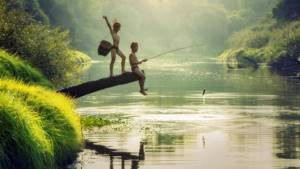
Places where fishing is prohibited:
- On inland waterways used for navigation (with some exceptions);
- In winter, in wintering pits approved by the list, within a certain period;
- On spawning grounds during the spawning period;
- Within the protected areas of hydraulic structures and bridges;
- At fish farming organizations at a distance of less than 0.5 km from fish cages;
- Within the boundaries of fish farms without agreement with their users;
- In prohibited and closed areas during periods prohibited for fishing.
Fishing places and types
Fishing rules divide water bodies into two types - public use and cultural fisheries. In the latter, you can catch sport fishing objects, but you must obtain a fishing license. Mining in them is carried out on a paid or free basis. Members of specialized societies may be issued vouchers, which entitles them to preferential conditions.
How to tie a shock leader to a spinning line - carrot and albright knots
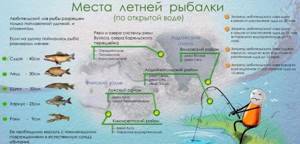
Currently, the following types of fishing exist:
- Amateur. The main sign is that the production will not be used as an object of sale in the future. Each region determines what can be fished with and a ban on activities during the spawning period.
- Sports. The goal is to catch fish of a certain species with maximum weight and size. To do this, they go to the sport fishing site, pre-issue a permit, a fishing ticket, and draw up regulations based on the current legislation.
- Promyslovaya. The peculiarity is the commercial component. The fish goes on sale. The type of prey is determined - red, white or black. After the license is issued, a ban on fishing for other types of fish automatically applies. In this case, it is permitted to catch a permissible minimum amount of a type of fish not specified in the license.
These types of fisheries also differ in the periods of prohibition of activities, fishing rules and the gear used. They are described on the Rosrybolovstvo website, but it is recommended to check the details at the local branch of the organization.
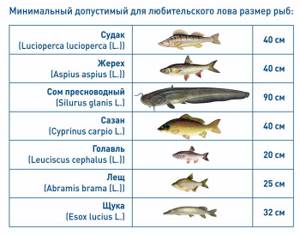
Fish sizes
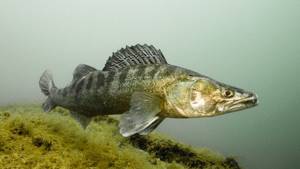
Fishing standards, minimum sizes allowed for catching and other restrictions vary and are established by the Fishing Rules for each region separately.
Ten popular fish and permitted minimum sizes:
- Asp – 40 cm;
- Pike perch – 40 cm;
- Bream – 30 cm;
- Pike – 37 cm;
- Carp – 40 cm;
- Freshwater catfish – 90 cm;
- Roach, roach – 17 cm;
- Chub – 25 cm;
- Ide – 25 cm;
- Tench – 22 cm.
For certain regions and water areas, the size of fish allowed for catch may be different.
Fish smaller than the specified size must be released. The length of the fish is measured from the closed mouth to the base of the caudal fin.
The minimum size of crayfish allowed to be caught is from 9 to 10 cm in quantity, no more than 30 pieces per person.
Prohibited fish species
The current rules either completely prohibit or limit the places and duration of fishing:
- trout;
- pike perch;
- pike;
Fishing of the following fish species is completely prohibited (except in certain areas):
- marine mammals;
- sturgeon species of fish;
- shemaya;
- light croaker;
- gurnard;
- carp;
- flounder;
- lampreys;
Important. In the case of production (catch) of prohibited species of aquatic biological resources, they must be released into the natural habitat with the least damage, regardless of their condition.
In order to preserve young animals, many regions have established minimum sizes of fish, the catch of which is prohibited.
When carrying out recreational and sport fishing, it is prohibited to harvest (catch) aquatic biological resources that have a fresh length less than that indicated in the table:
Minimum length of fish allowed for catching
Name of aquatic biological resources
| Length, cm | |
| Freshwater catfish | 60 |
| Carp | 35 |
| Taran | 16 |
| Rybets, raw | 22 |
| Sinets | 24 |
| white cupid | 45 |
| Barbels | 20 |
| Podust | 15 |
| Bersh | 26 |
| Asp | 35 |
| Silver carps | 50 |
| Chekhon | 24 |
| Pilengas | 38 |
| Tench | 17 |
| Pike | 30 |
| Ide | 26 |
| Gobies | 10 |
| Crayfish (freshwater crayfish) | 9 |
| Flounder glossa | 17 |
| Mullet (singil, mullet, pointed nose) | 20 |
| Horse mackerel | 10 |
Official documents
Federal Law “On Fisheries and Conservation of Aquatic Biological Resources” (as amended on December 5, 2021) (as amended on April 1, 2021) - link.
Fishing rules for individual regions of the Russian Federation
Azov-Black Sea fishery basin – link; Volga-Caspian fishery basin - link; Western Fishery Basin – link; Baikal fishery basin – link; Far Eastern fishery basin - link; West Siberian fishery basin - link.
Amateur and sport fishing in the Russian Federation is regulated by law and the rules referenced above.
Documents regulating fishing rules
The main document is considered to be the Federal Law “On Fisheries” also today. Also, for specific basins and water areas to which reservoirs belong, there are their own fishing principles: (Volga-Khvalynsky, Azov-Black Sea, Western and other fishery basins - names of fishing rules for specific basins)
Conclusion
Knowledge of the permitted fishing methods and the rules governing fishing in certain basins will help to avoid unnecessary problems and troubles for both experienced fishermen and beginners. Ignorance of the law has never spared a single soul from responsibility.
The use of gear permitted for fishing and the rules stipulating fishing in certain pools will help to avoid unnecessary problems and troubles for both experienced fishermen and beginners. Ignorance of the law has never spared a single soul from responsibility.
Prohibited tricks
However, even if the spawning time has passed, it is worth remembering that some restrictions may apply throughout the season. There are also general rules - you should not go fishing in the reserve or use prohibited fishing gear. But most often, individual restrictions are set at the regional level and may vary from reservoir to reservoir.
For example, in some areas they may be required to purchase a fishing license (this is also done in habitats of rare or valuable species - for example, in Karelia, where people come specifically to “hunt” for salmon). In addition, in this case, in this case, a special fee is sometimes required to be paid for each individual caught. And everywhere there are restrictions on the minimum sizes of fish allowed to be caught - they are set for certain breeds. All individuals that do not reach the required size will have to be released into the wild.
Fish_3
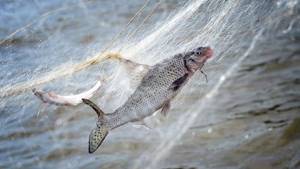
Fish in a poacher's net
Photo: TASS/Yuri Smityuk
Finally, in most regions of Russia, amateurs are strictly prohibited from using networks. And where this is allowed, you need to purchase a separate license for them, providing the fishing gear with name tags.
MORE ON THE TOPIC

A gang of poachers was detained on Lake Ladoga
Poachers were detained in the Volgograd region after a chase with shooting
Three poachers were detained with burbot in the Saratov region
A resident of the Murmansk region received 5 months in prison for catching salmon.
The problem is not only that nets are still a means of mass fishing. Abandoned by fishermen or vacationing tourists, they often lead to the death of fish, waterfowl and even animals entangled in them. Otters and beaver cubs also die in nets.
Therefore, before you go fishing, it is worth studying the rules in force in the desired area (including checking whether any of the local fish species are generally prohibited from catching). This can be done in the regional departments of Rosrybolovstvo, a complete list of which is on the department’s website.
